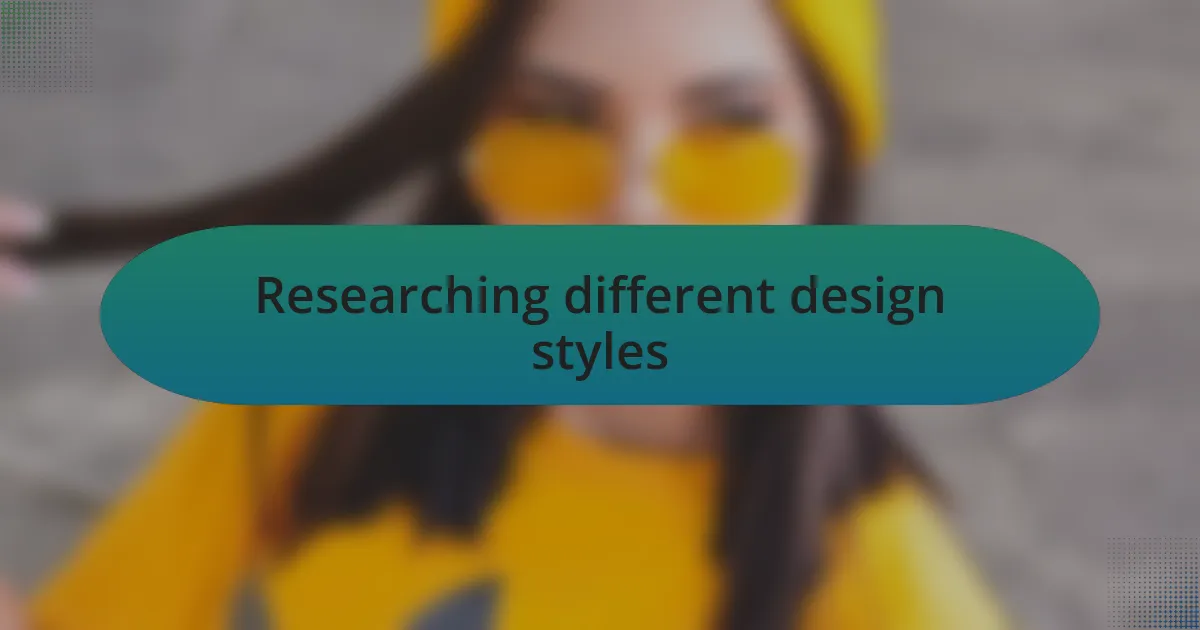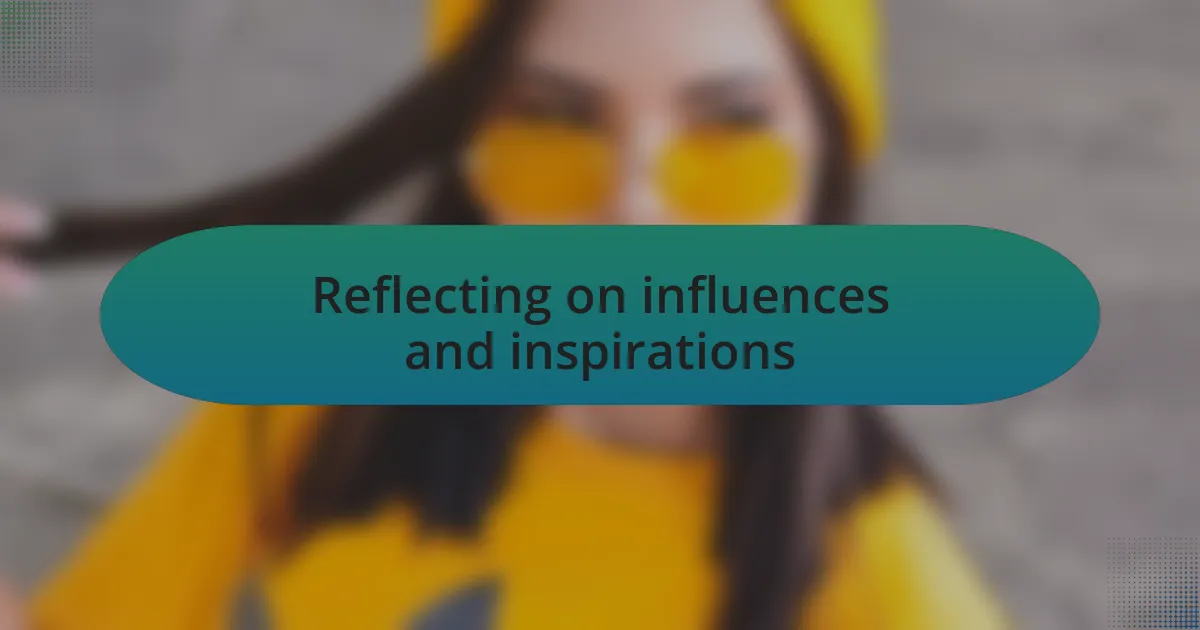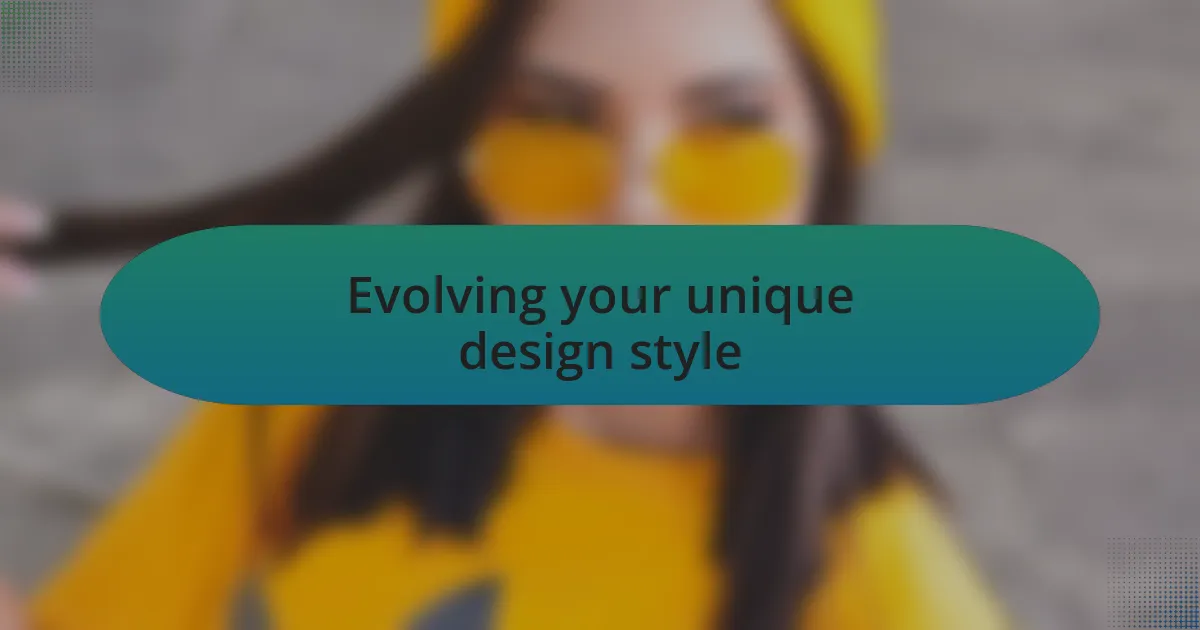Key takeaways:
- Understanding one’s design style is a personal journey that intertwines past experiences, emotions, and stories reflected in wardrobe choices.
- Finding a unique design style fosters confidence and recognition, allowing for authentic creative expression that connects with audiences.
- Engaging with different design styles and documenting the creative process helps clarify personal preferences and patterns that shape one’s evolution as a designer.
- Emotional connections to design—drawing from experiences and inspirations—create a unique narrative within one’s work, enhancing artistic authenticity.

Understanding design style
Understanding your design style can be a deeply personal journey. I remember sifting through countless fashion magazines and being struck by a particular aesthetic that resonated with me — it was like discovering a piece of myself I never knew existed. Have you ever flipped through pages and felt an electric connection to a specific look or color palette?
Each designer has a unique fingerprint, shaped by experiences, culture, and emotions. Reflecting on my past projects, I noticed that my creations often echoed my love for vintage silhouettes, blending them with modern elements. This realization was a pivotal moment, highlighting how our past can inform our present style.
Are there certain pieces in your wardrobe that tell a story? For me, it was an old leather jacket passed down from my father that sparked my interest in mixing textures and materials. It serves as a reminder that understanding design style is not just about aesthetics; it’s about weaving personal narratives into each choice we make.

Importance of finding your style
Finding your design style is critical because it instills confidence in your creative decisions. I remember stepping into a fabric store, overwhelmed by the choices around me. Suddenly, I spotted a bolt of fabric that captured my attention — a rich mustard yellow that seemed to call out to me. That moment was pivotal; it wasn’t just about the color but about realizing how much my preferences could influence my designs. Have you ever had a similar experience where a single piece sparked a flood of inspiration?
Moreover, having a distinct style can differentiate you in a crowded fashion landscape. When I began to embrace my unique aesthetic, I noticed that it wasn’t just my designs that stood out; people started to recognize my work as authentically “me.” This recognition deepened my connection to my craft, allowing me to explore innovative ideas without second-guessing myself. How can we create a brand that encapsulates our spirit if we lack clarity in our style?
Understanding your design style also fosters a deeper connection with your audience. Many times, I’ve received feedback from clients who felt a personal resonance with certain elements in my work, often tied to shared cultural experiences. These moments remind me that when we pour our authentic selves into our designs, it creates a dialogue that transcends the garment itself. Isn’t it amazing how style can serve as a bridge between designer and admirer?

Researching different design styles
Researching different design styles is an intriguing journey that involves exploring various influences and inspirations. I remember spending countless hours scrolling through fashion magazines and websites, soaking in different aesthetics. Each page turned revealed a new facet of creativity, from minimalist Scandinavian designs to the vibrant patterns of African textiles. What styles resonate with you, and have you ever felt drawn to a particular culture’s approach to fashion?
One exercise that transformed my understanding was creating a mood board for each style I admired. I’d clip images and fabrics that spoke to me, letting my intuition guide the selection process. It was fascinating to see how these visual collections reflected not just aesthetic preferences but also my emotional responses to different designs. Have you ever created a mood board? It can be a powerful way to visualize your evolving style.
Engaging in discussions with other designers and attending workshops also enriched my exploration of design styles. I distinctly recall a panel discussion where seasoned designers shared their journeys. Their stories highlighted how their backgrounds and experiences shaped their work, inspiring me to see my own influences in a new light. Perhaps you’ve had a similar revelation about the impact of community on your creative development? These collective insights often illuminate paths I hadn’t considered before, reminding me of the vibrant tapestry of design itself.

Experimenting with personal wardrobe
Experimenting with my personal wardrobe was a game changer in identifying my design style. I began by mixing and matching pieces that I felt drawn to but had never paired together before. One day, I threw on a vintage floral blouse with high-waisted jeans and felt an instant spark of joy. It made me wonder: have you ever put something together that made you see your clothes in a completely different light?
As I rummaged through my closet, I discovered items I’d forgotten about, some that had deep sentimental value. For instance, a hand-me-down jacket from my grandmother not only brought nostalgia, but it also inspired me to consider incorporating thrifted pieces into my designs, blending history with modern trends. This process made me realize how clothing can carry stories and evoke emotions. How do you think your wardrobe reflects your personal journey?
Finally, I took it a step further by documenting my outfit choices over a month. This simple act unveiled patterns in my preferences—colors and silhouettes I gravitated toward repeatedly. Revisiting these images, I noticed a natural alignment with certain design styles I had researched. It was like unraveling a mystery of my style evolution. Have you ever looked back at your outfits and felt a shift in your perspective on fashion?

Reflecting on influences and inspirations
Reflecting on influences and inspirations often brings back memories of pivotal moments in my fashion journey. I vividly recall flipping through vintage fashion magazines during my high school years, captivated by the bold designs and unique aesthetics of the past. It made me wonder: how many of us have our creativity sparked by the iconic styles of earlier decades?
One afternoon, I visited a local art gallery featuring an exhibit on textile design, and it was a revelation for me. The interplay of colors and textures in the artwork ignited a creative fire within. I found myself sketching ideas inspired by those visuals, realizing how deeply art influences fashion design. Have you ever experienced inspiration from an unexpected source, turning mundane moments into extraordinary ideas?
As I delved deeper into my childhood fashion influences, I began to see patterns in what attracted me. My mother’s eclectic collection of accessories often had me playing dress-up, mixing oversized earrings with bold prints. This not only shaped my aesthetic but also instilled in me an appreciation for eclecticism. Looking back, I realize: do our earliest memories of fashion shape the designers we aspire to be later in life?

Documenting your design journey
Documenting your design journey is an invaluable practice that allows you to capture your evolving thoughts and inspirations. I remember the first time I decided to keep a journal dedicated solely to my design ideas. Flipping through those pages now feels like stepping back in time. It’s fascinating to see how my early sketches started as clumsy interpretations yet grew into something recognizably me. Have you ever looked back at your own drafts and felt a twinge of nostalgia?
As I progressed in my design journey, I began incorporating photographs of my work, fabric swatches, and even snippets from conversations with fellow creatives. This multi-faceted approach not only provides context but also serves as a visual representation of my growth. I often find myself reflecting on the emotional highs and lows captured in that journal—like the excitement of completing my first collection or the frustration when a vision didn’t come to life as expected. Does your documentation encapsulate those ups and downs, too?
I also discovered the significance of setting regular intervals for reflection. I made it a point to review my documented journey at the end of each season. This ritual helped me identify the design elements I gravitated toward and recognize patterns in my personal development. Seeing those shifts in my style over time has been enlightening—it’s almost like getting to know yourself all over again. How often do you take the time to reconnect with your creative evolution?

Evolving your unique design style
Finding my unique design style has been a journey of constant evolution. There was a time when I felt confined to specific trends, but as I navigated through different influences, I started to blend those elements into something distinctly mine. Have you ever felt like you were merely imitating what’s popular, only to realize that your true voice was waiting to be uncovered?
One pivotal moment for me was during a workshop where each participant showcased their work. I was surprised to see that what resonated most with others were the pieces I created when I followed my instincts rather than adhering to industry norms. This realization sparked a desire to push away from traditional boundaries and explore personal storytelling within my designs. How often do you find yourself drawing inspiration from what genuinely excites you, rather than what you think others will like?
As I embraced this creative freedom, I noticed how my emotional connection to my work deepened. My design style became a reflection of my experiences and emotions—be it joy, heartbreak, or adventure. Each collection started to tell a story that was uniquely mine, and this personal narrative became the backbone of my evolving style. Have you considered how your own life experiences shape the designs you create?